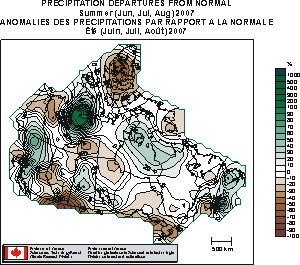| français | Contact Us | Help | Search | Canada Site |
| What's New | Topics | Publications | Weather | Home |
| About Us | ||||
| MSC - EC - GC | ||||
Regional Summary
About this Bulletin
Related Links
Past Bulletins
Climate Research Branch
Climate Trends and Variations Bulletin
Temperature & Precipitation in Historical Perspective
Annual 2005
National Temperature
 The
2005 national average temperature was 1.7°C above normal, based on preliminary
data. This ranks 2005 tied for third warmest, since nationwide records began
in 1948, along with 2001 and 1999. The map
to the right shows that all of Canada experienced above normal temperatures,
with most of the country at least 1░C above normal and the southwest edge of
the Yukon Territories 3░C above normal. With the exception of the springs of
2002 and 2004,
seasonal temperatures have remained above normal for more than 8 years, as shown
in the consecutive seasons
graph.
The
2005 national average temperature was 1.7°C above normal, based on preliminary
data. This ranks 2005 tied for third warmest, since nationwide records began
in 1948, along with 2001 and 1999. The map
to the right shows that all of Canada experienced above normal temperatures,
with most of the country at least 1░C above normal and the southwest edge of
the Yukon Territories 3░C above normal. With the exception of the springs of
2002 and 2004,
seasonal temperatures have remained above normal for more than 8 years, as shown
in the consecutive seasons
graph.
 The
graph to the left shows
that annual temperatures have generally been increasing nationally, with temperatures
remaining above normal for the last 9 years. The red dashed line represents
a warming trend of 1.2°C over the last 58 years. Listed in the national
warmest/coolest temperature table are the ten coolest and warmest years
for the entire country. This table shows that 1998 (+2.5░C) was the warmest
year, and 1972 (-1.8░C) was the coolest. The national
temperature departures table shows the full list of years in the order from
warmest to coolest, and shows that 6 of the warmest 10 years have occurred within
the last 10 years.
The
graph to the left shows
that annual temperatures have generally been increasing nationally, with temperatures
remaining above normal for the last 9 years. The red dashed line represents
a warming trend of 1.2°C over the last 58 years. Listed in the national
warmest/coolest temperature table are the ten coolest and warmest years
for the entire country. This table shows that 1998 (+2.5░C) was the warmest
year, and 1972 (-1.8░C) was the coolest. The national
temperature departures table shows the full list of years in the order from
warmest to coolest, and shows that 6 of the warmest 10 years have occurred within
the last 10 years.
National Precipitation
 Overall,
Canada experienced its wettest year on record in 2005, 13.4% above normal, based
on preliminary data. The map
to the right shows that most of the country was wetter than normal, with most
of Yukon; some of the southern Northwest Territories; most of Nunavut; southwest
coast of B.C.; southern Alberta; most of Saskatchewan and Manitoba; the extreme
north of Quebec; and the western part of Nova Scotia experienced at least 20%
more precipitation than normal. The main areas which experienced precipitation
at least 20% below normal were: along the west coast of B.C.; the eastern edge
of B.C. and the western edge of Alberta.
Overall,
Canada experienced its wettest year on record in 2005, 13.4% above normal, based
on preliminary data. The map
to the right shows that most of the country was wetter than normal, with most
of Yukon; some of the southern Northwest Territories; most of Nunavut; southwest
coast of B.C.; southern Alberta; most of Saskatchewan and Manitoba; the extreme
north of Quebec; and the western part of Nova Scotia experienced at least 20%
more precipitation than normal. The main areas which experienced precipitation
at least 20% below normal were: along the west coast of B.C.; the eastern edge
of B.C. and the western edge of Alberta.
It should be noted that "normal" precipitation in northern Canada is generally much less than it is in southern Canada, and hence a percent departure in the north represents much less difference in actual precipitation than the same percentage in the south. The national precipitation rankings are therefore often skewed by the northern departures and do not represent rankings for the volume of water falling on the country.
 The graph to the left
shows that the last four years have been wetter than normal and that since 1973
only 3 annual values have been drier than normal. As shown in the national
precipitation wettest/driest table, the second wettest year was 1996 (+9.1%)
and the driest was 1956 (-7.3%). The national
precipitation departures table shows the full list of annual precipitation
values in order from wettest to driest. The last 5 seasons have been wetter
than normal, as shown in the
consecutive seasons graph.
The graph to the left
shows that the last four years have been wetter than normal and that since 1973
only 3 annual values have been drier than normal. As shown in the national
precipitation wettest/driest table, the second wettest year was 1996 (+9.1%)
and the driest was 1956 (-7.3%). The national
precipitation departures table shows the full list of annual precipitation
values in order from wettest to driest. The last 5 seasons have been wetter
than normal, as shown in the
consecutive seasons graph.
/ccrm/bulletin/national_e.cfm
The Green LaneTM,
Environment Canada's World Wide Web Site.